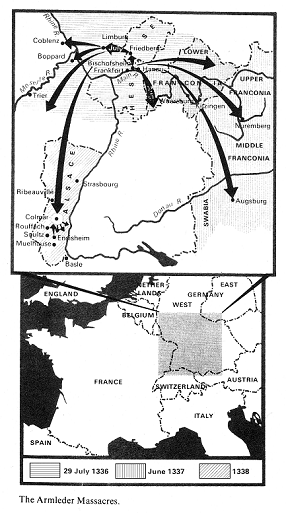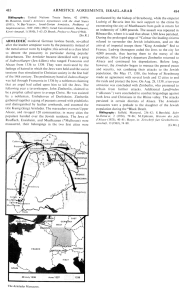|

 Map
of
the Armleder pogroms 1336-1339 Map
of
the Armleder pogroms 1336-1339
|
<ARMLEDER, medieval German lawless bands, so-called
after the leather arm piece worn by the peasantry instead
of the metal armor worn by knights; this served as a class
label to denote the peasantry in particular during popular
disturbances. The
Armleder
became identified with a gang of
Judenschlaeger (Jew-killers
[Jew-beaters]) who ranged Franconia and Alsace from 1336
to 1339. They were motivated by the feelings of hatred in
which the Jews were held and the social tensions thus
stimulated in Christian society in the first half of the
14th century.
[1936: Armleder
Jew-beaters bands in Franconia - 1937:
Zimberlin-Umbehoven gang pogroms and "king Armleder"]
The preliminary band of
Judenschlaeger
was led through Franconia in 1336
by a nobleman claiming
that an angel had called upon him to kill the Jews. The
following year a tavernkeeper,
John Zimberlin, claimed to be a prophet
called upon to avenge Christ. He was assisted by a
nobleman,
Umbehoven of
Dorlisheim. Zimberlin gathered together a gang of
peasants armed with pitchforks and distinguished by
leather armbands, and assumed the title
Kunig (king) Armleder.
[Pogroms and massacres in
Alsace - the bishop of Strasbourg is confiscating Jewish
possessions - Bavarian
king Ludwig is
taking a fine]
The marauders overran Upper Alsace, and ravaged 120
communities; in many cities the populace handed over the
Jewish residents. The Jews of Rouffach, Ensisheim, and
Muelhausen (*Mulhouse) were massacred, their belongings in
the two first cities were (col. 483)
confiscated by the
bishop
of Strasbourg, while the emperor
Ludwig of Bavaria lent
his tacit support to the crime by exonerating the city of
Muelhausen from guilt in return for an indemnity of 1,000
pounds. The assault was repeated in Ribeauville, where it
is said that about 1,500 Jews perished.
[Siege of Colmar:
Resistance of the population - "King Armleder" has to
flee - king Ludwig takes money for leaving the Jews
alive]
During the prolonged siege of *Colmar the leading citizens
refused to surrender the Jewish inhabitants, and on the
arrival of imperial troops there "King Armleder" fled to
France; Ludwig thereupon ceded the Jews to the city for
4,000 pounds, thus leaving them to the mercy of the
populace.
After Ludwig's departure Zimberlin returned to Alsace and
continued his depredations. Before long, however, the
Armleder began to
menace the general peace and security, not confining their
attacks to the Jewish population.
[17 May 1338: End of the
pogroms - 28 Aug 1339: 10 year armistice - Landfrieden]
On May 17, 1338, the bishop of Strasbourg made an
agreement with several lords and 12 cities to end the
raids and protect the Jews. On Aug. 28, 1339, a ten-year
armistice was concluded with Zimberlin, who promised to
refrain from further attacks.
Additional Landfrieden ("alliances") were concluded to
combat brigandage against both Jews and Christians in the
Rhine valley. The attacks persisted in certain districts
of Alsace. The
Armleder
massacres were a prelude to the slaughter of the Jewish
population during the *Black Death.
Map of the Armleder pogroms 1336-1339




